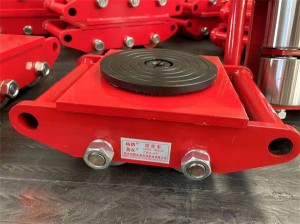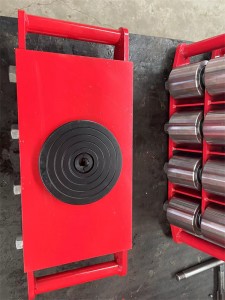1, Assessment - Begin by assessing the path you'll need to navigate and the weight of the machine being moved. Determine the number of machine moving skates required and ensure they have the appropriate capacity.
2, Surface Preparation - Ensure the pathway is clear and free of debris, cracks, or holes. Reinforce any weak spots in the surface with steel plates.
3, Positioning - Lift the heavy machine using a hydraulic jack, hoist, fork truck, or similar lifting equipment to place the machine moving skates underneath. Ensure the skates are positioned correctly to support the weight.
4, Skate Types - Different skate types are available for straight-line movement, steering, or multidirectional needs. Choose the appropriate skate type for your application. Rotating or swivel skates provide more maneuverability, while fixed skates are better for straight lines.
5, Skate Placement - The load configuration and weight will determine the number and arrangement of skates. Consider using wooden skids or blocking to support the load, especially if the machine doesn't have built-in skids.
6, Path Planning - Plan the route carefully, considering the shape and size of the load. Map out the pathway and identify potential obstacles.
7, Motive Power - For very heavy loads, consider using powered or battery-operated machine skates that can be remote-controlled, which eliminates the need for manual pushing or pulling. Forklifts or other machinery may also be required to assist with the move.
8, Safety - Ensure operators are trained and aware of safety protocols. Never exceed the capacity of the skates. Use appropriate personal protective equipment and ensure workers are aware of the movement of the heavy machinery.
9, Surface Protection - If the floor or surface is vulnerable to damage, consider using polyurethane-coated rollers or place protective materials under the skates.
10, Maintenance - After the move, inspect the machine moving skates, replace any worn parts, and perform regular maintenance to ensure they're in good condition for the next use.
Remember that these steps are a general guide, and the specific steps may vary depending on the situation. Machine moving skates are specialized tools, so prior experience and expert advice should be sought for safer and more efficient heavy machine relocation.
1, Assessment - Begin by assessing the path you'll need to navigate and the weight of the machine being moved. Determine the number of machine moving skates required and ensure they have the appropriate capacity.
2, Surface Preparation - Ensure the pathway is clear and free of debris, cracks, or holes. Reinforce any weak spots in the surface with steel plates.
3, Positioning - Lift the heavy machine using a hydraulic jack, hoist, fork truck, or similar lifting equipment to place the machine moving skates underneath. Ensure the skates are positioned correctly to support the weight.
4, Skate Types - Different skate types are available for straight-line movement, steering, or multidirectional needs. Choose the appropriate skate type for your application. Rotating or swivel skates provide more maneuverability, while fixed skates are better for straight lines.
5, Skate Placement - The load configuration and weight will determine the number and arrangement of skates. Consider using wooden skids or blocking to support the load, especially if the machine doesn't have built-in skids.
6, Path Planning - Plan the route carefully, considering the shape and size of the load. Map out the pathway and identify potential obstacles.
7, Motive Power - For very heavy loads, consider using powered or battery-operated machine skates that can be remote-controlled, which eliminates the need for manual pushing or pulling. Forklifts or other machinery may also be required to assist with the move.
8, Safety - Ensure operators are trained and aware of safety protocols. Never exceed the capacity of the skates. Use appropriate personal protective equipment and ensure workers are aware of the movement of the heavy machinery.
9, Surface Protection - If the floor or surface is vulnerable to damage, consider using polyurethane-coated rollers or place protective materials under the skates.
10, Maintenance - After the move, inspect the machine moving skates, replace any worn parts, and perform regular maintenance to ensure they're in good condition for the next use.
Remember that these steps are a general guide, and the specific steps may vary depending on the situation. Machine moving skates are specialized tools, so prior experience and expert advice should be sought for safer and more efficient heavy machine relocation.
Post time: Jun-12-2024






